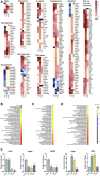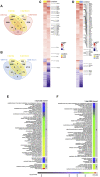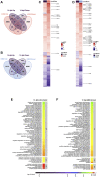Brain Regeneration Resembles Brain Cancer at Its Early Wound Healing Stage and Diverges From Cancer Later at Its Proliferation and Differentiation Stages
- PMID: 35223842
- PMCID: PMC8868567
- DOI: 10.3389/fcell.2022.813314
Brain Regeneration Resembles Brain Cancer at Its Early Wound Healing Stage and Diverges From Cancer Later at Its Proliferation and Differentiation Stages
Abstract
Gliomas are the most frequent type of brain cancers and characterized by continuous proliferation, inflammation, angiogenesis, invasion and dedifferentiation, which are also among the initiator and sustaining factors of brain regeneration during restoration of tissue integrity and function. Thus, brain regeneration and brain cancer should share more molecular mechanisms at early stages of regeneration where cell proliferation dominates. However, the mechanisms could diverge later when the regenerative response terminates, while cancer cells sustain proliferation. To test this hypothesis, we exploited the adult zebrafish that, in contrast to the mammals, can efficiently regenerate the brain in response to injury. By comparing transcriptome profiles of the regenerating zebrafish telencephalon at its three different stages, i.e., 1 day post-lesion (dpl)-early wound healing stage, 3 dpl-early proliferative stage and 14 dpl-differentiation stage, to those of two brain cancers, i.e., low-grade glioma (LGG) and glioblastoma (GBM), we reveal the common and distinct molecular mechanisms of brain regeneration and brain cancer. While the transcriptomes of 1 dpl and 3 dpl harbor unique gene modules and gene expression profiles that are more divergent from the control, the transcriptome of 14 dpl converges to that of the control. Next, by functional analysis of the transcriptomes of brain regeneration stages to LGG and GBM, we reveal the common and distinct molecular pathways in regeneration and cancer. 1 dpl and LGG and GBM resemble with regard to signaling pathways related to metabolism and neurogenesis, while 3 dpl and LGG and GBM share pathways that control cell proliferation and differentiation. On the other hand, 14 dpl and LGG and GBM converge with respect to developmental and morphogenetic processes. Finally, our global comparison of gene expression profiles of three brain regeneration stages, LGG and GBM exhibit that 1 dpl is the most similar stage to LGG and GBM while 14 dpl is the most distant stage to both brain cancers. Therefore, early convergence and later divergence of brain regeneration and brain cancer constitutes a key starting point in comparative understanding of cellular and molecular events between the two phenomena and development of relevant targeted therapies for brain cancers.
Keywords: comparative transcriptome analysis; differentiation; glioblastoma; low-grade glioma (LGG); proliferation; wound healing; zebrafish.
Copyright © 2022 Demirci, Heger, Katkat, Papatheodorou, Brazma and Ozhan.
Conflict of interest statement
The authors declare that the research was conducted in the absence of any commercial or financial relationships that could be construed as a potential conflict of interest.
Figures








Similar articles
-
Comparative Transcriptome Analysis of the Regenerating Zebrafish Telencephalon Unravels a Resource With Key Pathways During Two Early Stages and Activation of Wnt/β-Catenin Signaling at the Early Wound Healing Stage.Front Cell Dev Biol. 2020 Oct 9;8:584604. doi: 10.3389/fcell.2020.584604. eCollection 2020. Front Cell Dev Biol. 2020. PMID: 33163496 Free PMC article.
-
Identification of potential biomarkers related to glioma survival by gene expression profile analysis.BMC Med Genomics. 2019 Mar 20;11(Suppl 7):34. doi: 10.1186/s12920-019-0479-6. BMC Med Genomics. 2019. PMID: 30894197 Free PMC article.
-
Differential expression of the circadian clock network correlates with tumour progression in gliomas.BMC Med Genomics. 2023 Jul 3;16(1):154. doi: 10.1186/s12920-023-01585-w. BMC Med Genomics. 2023. PMID: 37400829 Free PMC article.
-
Common and Distinct Features of Adult Neurogenesis and Regeneration in the Telencephalon of Zebrafish and Mammals.Front Neurosci. 2020 Sep 23;14:568930. doi: 10.3389/fnins.2020.568930. eCollection 2020. Front Neurosci. 2020. PMID: 33071740 Free PMC article. Review.
-
Histochemical, Biochemical and Cell Biological aspects of tail regeneration in lizard, an amniote model for studies on tissue regeneration.Prog Histochem Cytochem. 2014 Jan;48(4):143-244. doi: 10.1016/j.proghi.2013.12.001. Epub 2014 Jan 1. Prog Histochem Cytochem. 2014. PMID: 24387878 Review.
Cited by
-
Telencephalic stab wound injury induces regenerative angiogenesis and neurogenesis in zebrafish: unveiling the role of vascular endothelial growth factor signaling and microglia.Neural Regen Res. 2025 Oct 1;20(10):2938-2954. doi: 10.4103/NRR.NRR-D-23-01881. Epub 2024 Sep 6. Neural Regen Res. 2025. PMID: 39248179 Free PMC article.
-
A syngeneic spontaneous zebrafish model of tp53-deficient, EGFRvIII, and PI3KCAH1047R-driven glioblastoma reveals inhibitory roles for inflammation during tumor initiation and relapse in vivo.Elife. 2024 Jul 25;13:RP93077. doi: 10.7554/eLife.93077. Elife. 2024. PMID: 39052000 Free PMC article.
-
Uncovering the spectrum of adult zebrafish neural stem cell cycle regulators.Front Cell Dev Biol. 2022 Jun 29;10:941893. doi: 10.3389/fcell.2022.941893. eCollection 2022. Front Cell Dev Biol. 2022. PMID: 35846369 Free PMC article. Review.
-
Mapping the cellular expression patterns of vascular endothelial growth factor aa and bb genes and their receptors in the adult zebrafish brain during constitutive and regenerative neurogenesis.Neural Dev. 2024 Sep 12;19(1):17. doi: 10.1186/s13064-024-00195-1. Neural Dev. 2024. PMID: 39267104 Free PMC article.
-
Canonical Wnt and TGF-β/BMP signaling enhance melanocyte regeneration but suppress invasiveness, migration, and proliferation of melanoma cells.Front Cell Dev Biol. 2023 Nov 13;11:1297910. doi: 10.3389/fcell.2023.1297910. eCollection 2023. Front Cell Dev Biol. 2023. PMID: 38020918 Free PMC article.
References
-
- Andrews S. (2010). A Quality Control Tool for High Throughput Sequence Data.
LinkOut - more resources
Full Text Sources
Molecular Biology Databases

